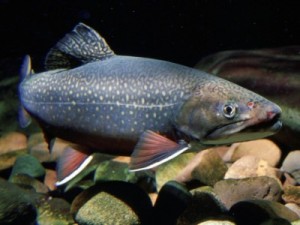
When trees fall into a stream, the result can be a mix of pools and shallow areas that are used by trout for feeding, reproducing, avoiding high flows, and hiding from predators.
In Vermont, a history of clearing streams and rivers has left many areas with fewer trees and less habitat for native brook trout.
More than 27 miles of brook trout streams have been improved by the placement of large trees in strategic locations to enhance habitat and stream function.
For example, a six-year study in the East Branch Nulhegan River watershed found that on average brook trout abundance tripled in just three years at sites with the added trees.
In addition to providing cover for trout, the added wood is storing sediment and organic material in these smaller headwater streams, thereby reducing sediment and nutrient loads downstream. The added wood also helps to slow runoff from these headwater streams, which can help to reduce flooding downstream.
The work has been conducted by the Vermont Fish and Wildlife Department and Trout Unlimited on lands owned by Weyerhaeuser, US Fish and Wildlife Service, and Vermont Fish and Wildlife.
Funding has been provided by a variety of sources including: Sportfish Restoration, Vermont fishing license sales, New Hampshire Charitable Foundation, National Fish and Wildlife Foundation, Eastern Brook Trout Joint Venture, and Ecosystem Restoration Funds through the Vermont Clean Water Initiative Program.
“This has been the most rewarding project of my career,” said Jud Kratzer, fisheries biologist with the Vermont Fish and Wildlife Department. “By adding this large woody material to streams, we are helping to reverse the legacy of historic clear cutting and repeated log drives on these streams. To see brook trout abundance respond so dramatically has been especially exciting.”
“While this effort has been a success, to achieve these kinds of results statewide is going to require leaving trees in the river in the first place, whenever possible. Wood is good for brook trout in particular and streams in general.”
For more information, visit: vtfishandwildlife.com.
source: Vermont Fish and Wildlife Department